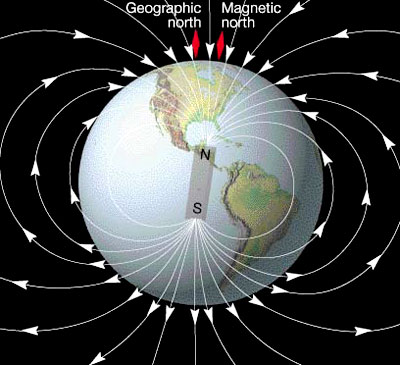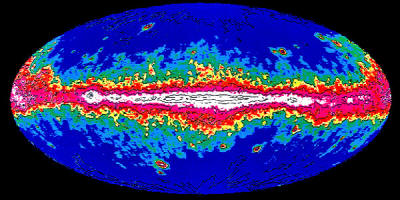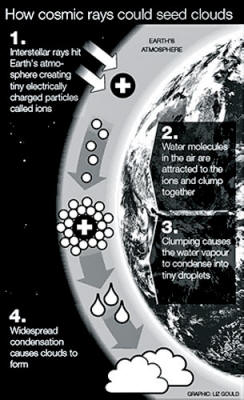|

2009
from
ViewZone Website
COPENHAGEN (AFP)
The earth's climate has been
significantly affected by the planet's magnetic field, according to
a Danish study published Monday that could challenge the notion that
human emissions are responsible for global warming.
"Our results show a strong
correlation between the strength of the earth's magnetic field
and the amount of precipitation in the tropics," one of the two
Danish geophysicists behind the study, Mads Faurschou Knudsen of
the geology department at Aarhus University in western Denmark,
told the Videnskab journal.

He and his colleague Peter Riisager,
of the Geological Survey of Denmark and Greenland (GEUS),
compared a reconstruction of the prehistoric magnetic field 5,000
years ago based on data drawn from stalagmites and stalactites found
in China and Oman.
The results of the study, which has also been published in US
scientific journal Geology, lend support to a controversial theory
published a decade ago by Danish astrophysicist Henrik Svensmark,
who claimed the climate was highly influenced by galactic cosmic
ray (GCR)
particles penetrating the earth's atmosphere.
Svensmark's theory, which pitted him against today's mainstream
theorists who claim carbon dioxide (CO2) is responsible
for global warming, involved a link between the earth's magnetic
field and climate, since that field helps regulate the number of GCR
particles that reach the earth's atmosphere.
"The only way we can explain the
(geomagnetic-climate) connection is through the exact same
physical mechanisms that were present in Henrik Svensmark's
theory," Knudsen said.
"If changes in the magnetic field, which occur independently of
the earth's climate, can be linked to changes in precipitation,
then it can only be explained through the magnetic field's
blocking of the cosmetic rays," he said.
Galactic
Cosmic Rays
Galactic cosmic rays (GCRs)
come from outside the solar system but generally from within our
Milky Way galaxy.

GCRs are atomic nuclei from which all of
the surrounding electrons have been stripped away during their
high-speed passage through the galaxy.
They have probably been accelerated
within the last few million years, and have traveled many times
across the galaxy, trapped by the galactic magnetic field.
GCRs have
been accelerated to nearly the speed of light, probably by supernova
remnants.
As they travel through the very thin gas
of interstellar space, some of the GCRs interact and emit gamma
rays, which is how we know that they pass through the Milky Way and
other galaxies.
The elemental makeup of GCRs has been studied in detail , and is
very similar to the composition of the Earth and solar system. But
studies of the composition of the isotopes in GCRs may indicate the
that the seed population for GCRs is neither the interstellar gas
nor the shards of giant stars that went supernova.
This is an area of current study.
Included in the cosmic rays are a number of radioactive nuclei whose
numbers decrease over time. As in the carbon-14 dating technique,
measurements of these nuclei can be used to determine how long it
has been since cosmic ray material was synthesized in the galactic
magnetic field before leaking out into the vast void between the
galaxies.
These nuclei are called "cosmic ray
clocks".
The two scientists acknowledged that CO2
plays an
important role in the changing climate,
"but the climate is an incredibly
complex system, and it is unlikely we have a full overview over
which factors play a part and how important each is in a given
circumstance," Riisager told Videnskab.
Svensmark's
Theory Explained
Man-made climate change may be happening at a far slower rate than
has been claimed, according to controversial new research.

Scientists say that cosmic rays from
outer space play a far greater role in changing the Earth's climate
than global warming 'experts' previously thought.
In a book, to be published this week, they claim that fluctuations
in the number of cosmic rays hitting the atmosphere directly alter
the amount of cloud covering the planet.
High levels of cloud cover blankets the Earth and reflects radiated
heat from the Sun back out into space, causing the planet to cool.
Henrik Svensmark, a weather scientist at the Danish National
Space Centre who led the team behind the research, believes that
the planet is experiencing a natural period of low cloud cover due
to fewer cosmic rays entering the atmosphere.
This, he says, is responsible for much of
the global 'warming' we are
experiencing.
He claims carbon dioxide emissions due to human activity are having
a smaller impact on climate change than scientists think. If he is
correct, it could mean that mankind has more time to reduce our
effect on the climate.
The controversial theory comes one week after 2,500 scientists who
make up the United Nations International Panel on Climate Change
published their fourth report stating that human carbon dioxide
emissions would cause temperature rises of up to 4.5°C by the end of
the century.
Mr Svensmark claims that the calculations used to make this
prediction largely overlooked the effect of cosmic rays on cloud
cover and the temperature rise due to human activity may be much
smaller.
He said:
"It was long thought that clouds
were caused by climate change, but now we see that climate
change is driven by clouds.
"This has not been taken into account in the models used to work
out the effect carbon dioxide has had.
"We may see CO2 is responsible for much less warming
than we thought and if this is the case the predictions of
warming due to human activity will need to be adjusted."
Mr Svensmark last week published (Influence
of Cosmic Rays on Earth's Climate)
the first experimental evidence from five years' research on the
influence that cosmic rays have on cloud production in the
Proceedings of the Royal Society Journal A: Mathematical, Physical
and Engineering Sciences.
This week he will also publish a fuller
account of his work in a book entitled
The Chilling Stars - A New Theory of Climate
Change.
A team of more than 60 scientists from around the world are
preparing to conduct a large-scale experiment using a particle
accelerator in Geneva, Switzerland, to replicate the effect of
cosmic rays hitting the atmosphere.
They hope this will prove whether this deep space radiation is
responsible for changing cloud cover. If so, it could force climate
scientists to re-evaluate their ideas about how global warming
occurs.
Mr Svensmark's results show that the rays produce electrically
charged particles when they hit the atmosphere.
He said:
"These
particles attract water molecules from the air and cause them to
clump together until they condense into clouds."
Mr Svensmark claims that the number of cosmic rays hitting the Earth
changes with the magnetic activity around the Sun.
During high
periods of activity, fewer cosmic rays hit the Earth and so there
are less clouds formed, resulting in warming.
Low activity causes more clouds and cools the Earth.
According to Svensmark:
"Evidence from ice cores show this
happening long into the past. We have the highest solar activity
we have had in at least 1,000 years.
"Humans are having an effect on climate change, but by not
including the cosmic ray effect in models it means the results
are inaccurate. The size of man's impact may be much smaller and
so the man-made change is happening slower than predicted."

Some climate change experts have
dismissed the claims as "tenuous".
Giles Harrison, a cloud specialist at Reading University said
that he had carried out research on cosmic rays and their effect on
clouds, but believed the impact on climate is much smaller than Mr
Svensmark claims.
Mr Harrison said:
"I have been looking at cloud data
going back 50 years over the UK and found there was a small
relationship with cosmic rays. It looks like it creates some
additional variability in a natural climate system but this is
small."
But there is a growing number of
scientists who believe that the effect may be genuine.
Among them is Prof Bob Bingham, a clouds expert from the Central
Laboratory of the Research Councils in Rutherford.
He said:
"It is a relatively new idea, but
there is some evidence there for this effect on clouds."
|




